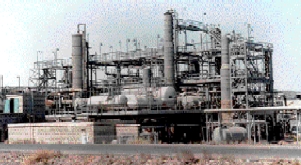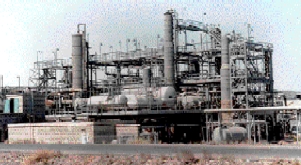
ADEN OIL REFINERY More Potential Accomplishments [Archives:2000/26/Business & Economy]
June 26 2000
Ridhwan Al-Saqqaf
Aden Bureau Chief
Yemen Times

Yemen Times interviewed Mr. Ibrahim Khalaf Hasan, General Director, Public Relations Dept. at the refinery. Excerpts:
Aden is privileged in having an excellent location at the cross roads of marine lines linking Europe, the Middle East, India and Australia. In 1919 British Petroleum (Aden) Ltd. established a bunkering unit at Steamer Point – Tawahi. After World War II demand increased and bigger tankers were built. At that time it was found that refining crude oil at marketing locations is more profitable than at areas of discovery. After Iran concluded its procedures for the nationalization of Abadan Refinery, BP agreed to build a new refinery somewhere East of Suez to fulfil demand in East and South Africa, the Red Sea and Indian Ocean area. Aden with its strategic location then, was called on by more than 5000 ships annually. Such a big number of vessels needing huge quantities of fuel products encouraged BP to build the refinery at Aden.
During 1952 BP signed contracts with BECHTEL of the USA and WIMPEY of the UK for building the new refinery which began in November 1952. It was concluded after 21 months on 15th July 1954. The first British tanker – called British Gratitude- carrying Kuwaiti crude oil arrived at Aden on 29th July 1954.
Aden Refinery was designed with a capacity to refine 5million barrels of crude oil annually. The total cost reached 45 million pounds. 2500 British, American and European technicians and 10000 Arab and Indian laborers were needed to complete the work.
Aden Refinery 1977- 1990:
On the 1st May, 1977 Aden refinery revertd to the ownership of the Yemeni government according to an agreement signed with the British company and was given the name Aden Refinery Co. At this time all equipment and machinery were in a urgent need not just for maintenance, but for continuous maintenance, after serving for more than a quarter of a century. The new nationalized company began studying and exploring new markets and customers. Production rose to 4.5 million metric tons annually. In 1984 the first modernization plan for the refinery began and included adding new productive units in order to maximize yields. A vacuum-distillation unit, an asphalt unit, a barrels factory and an Ethane gas unit were built in addition to 3 spherical-shaped tanks capable of holding 3000 metric tons of gas. These projects cost $22 million. To match the modern developments of oil tankers the company began its second plan aimed at the development and modernization of the fuel port at the refinery.
During 1986 work began on updating the four terminals at the refinery port and deepening approaches towards them. Modern technology input was aimed at enabling the terminals to receive big oil tankers, upto 110,000 tons. A special port was built for the export of asphalt and cooking gas and to receive 22,000 ton vessels. Total costs of this project were $55 million.
The Refinery after the Unity of Yemen:
When the blessed unity of Yemen was achieved on 22nd May, 1990 the refinery continued to provide Yemen with its needs of fuel products and thus saved the country a lot of foreign hard currency. It provides several fuel products to the local market: benzene, diesel, cooking gas, fuels for airplanes, ships and power stations, kerosene and asphalt.
The asphalt industry development project is the most important addition to the national economy. Nearly 50000 tons of asphalt are produced annually and used for roads and airports all over the Republic. Old storage tanks were maintained while new ones were added. By 1992 16 new storage tanks were added, of which two were big ones (100,000 tons) for crude oil arriving from Marib and Masila. The 14 other tanks bring the total storage capacity to 250,000 tons of crude oil. During 1999 two new tanks, 25,000 tons each were added.
Training
The training center at the refinery was established in 1955 when a pressing need for the training of young Yemenis prevailed, to enable them to work at the refinery. The first group consisted of Primary school graduates who joined the project. The best of these were sent to the Technical Institute at Maalla, to join electricity and mechanics courses. They were trained to sit for the City & Guilds Certificate exam papers that came from London. Some of these occupied high posts of supervision at the refinery due to the high level of qualifications they obtained. The training department played a great role and its graduates are manning several refineries all over the Arab Peninsula and elsewhere. Aden Refinery became similar to a college that supplied the region with well trained and expert manpower.
The Refinery includes other departments such as the technical laboratory, which tests all products and makes sure they agree to international quality levels before exporting them. There are maintenance departments, stores, engineering services, engineering testing departments and several service departments. There is a private hospital for the Refinery personnel, laborers and their families and those of the neighborhood. There is a sports club and a golf range, a tennis court and a general service hall.
What characterizes the Refinery are the efforts aimed at overcoming the effects of the weather in order to protect the machinery and tools by adapting a periodical and uniform range of maintenance applied by skillful Yemeni labor. The Refinery is run by a total of about 3000 male and female workers.
The Most Important Projects Under Implementation:
Some of the most important projects that are being implemented now in the Refinery are:
A: Building 6 new storage tanks for oil and oil products, which is nicknamed the Russian Tanks project. Materials for this project were imported during the late 80s -from the defunct USSR- and remained at the port of the Refinery. It was the wise decision by management which insisted on concluding the project which rescued these materials. Total storage capacity of this project is 61000 tons, including:
1- 10,000 tons Naphtha products storage tank.
2- Two 10,000 tons benzene products storage tanks.
3- 10,000 tons gas oil storage tank.
4- 20,000 tons Solar storage tank.
5- 1000 tons benzene storage tank.
This project is implemented by the Engineering Services Department at the Refinery with Romanian assistance from Romconsult Co.
B) Building 10 Cylindrical Storage tanks for Butagas
C) Repairing 7 Old Crude and oil product storage tanks.
D) Introducing a a complete, overall electronic information system net by introducing computers in all departments of the refinery.
E)Future Project:
– A 35-40Megawatt power station.
– Developing 2 crude oil refining units
– Developing a vehicles benzene unit (Catlaytic_Reformer)
– Building One benzene and kerosene processing unit
– Building a new unit for breaking gas oil into simpler products.
——
[archive-e:26-v:2000-y:2000-d:2000-06-26-p:./2000/iss26/b&e.htm]


